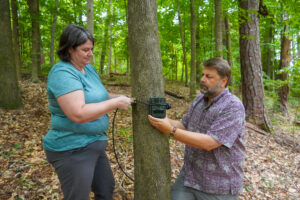
Jean Fantle-Lepczyk (left) and Chris Lepczyk (right) mount a game camera to a tree for wildlife research.
Researchers at the Auburn University College of Forestry, Wildlife and Environment (CFWE) say that human interaction and wildlife presence go hand in hand, especially during a global pandemic. Recent studies conducted at the Kreher Preserve and Nature Center (KPNC) reveals the importance of using a citizen science framework to conduct research and outreach.
The CFWE team lead by Christopher Lepczyk, the Alumni Professor of wildlife biology and conservation, and Jean Fantle-Lepczyk, assistant research professor, gathered crucial wildlife data for a coauthored paper titled “Mammal responses to global changes in human activity vary by trophic group and landscape.”
The paper was recently published in Nature Ecology & Evolution, a premier publisher of high-quality research. The study reports that a global dataset of cameras illustrates how wildlife altered their behavior when faced with fluctuating human activity during the COVID-19 pandemic.

A coyote captured on a game camera at Kreher Preserve & Nature Center.
The perfect learning environment
As a piece of the larger, 37-country research puzzle, Lepczyk and Fantle-Lepczyk focused on acquiring information during the pandemic lockdown period (March 2020-January 2021) in support of the long-term Snapshot USA project. Their research took place at the Kreher Preserve and Nature Center (KPNC) located in northern Auburn, Alabama, where they worked alongside Michael Buckman, KPNC manager.
“I was approached by Dr. Lepczyk because the conditions at the KPNC were a perfect fit for the data he was collecting for the project,” Buckman said. “I was very excited to get involved because, in addition to supporting this important project, we would also be gathering some very valuable information about wildlife populations at the KPNC that we can use in our own environmental education programming.”
According to Buckman, the KPNC offers several opportunities for citizen science, a term that references the public’s voluntary involvement in scientific research. From invited studies on monarch butterflies to counting songbirds, visitors to the KPNC are able to participate in studies that provide useful data for researchers.
The study employed various research methods including the placement of camera traps in multiple locations where photos would capture animal movement. The scientists would then categorize each image based on species, animal type and habits.
“By placing cameras out during late summer through early fall each year in the same places, we are able to gather a long-term dataset of what species are on the preserve and when they are active, allowing us deeper insights into a wide range of animals,” said Lepczyk.
This research proved useful to learn about wildlife biodiversity, and their relationship with people and their activities. Furthermore, the upticks in visitation to the KPNC during COVID-19 proved to be an excellent opportunity for researchers and staff to work together.
“This study is extremely helpful in understanding the degree activities within the KPNC impact our wildlife populations, and how we can use these data to manage our forests (and visitors) to ensure we continue to provide good wildlife habitat,” Buckman said. “The results are also just fun and fascinating.”

Jean Fantle-Lepczyk (left) and Chris Lepczyk (right) walk down a trail while discussing wildlife research.
Results show importance of research
The global study revealed that increasing traffic to areas such as the KPNC reflected more mammal activity in modified landscapes, indicating that the increasing presence of people in outdoor recreation areas also influences the presence of wildlife. In less modified, more wild landscapes, mammals became less active.
Among approximately 1,065 global research responses, human interaction increased activity in some mammal species within recreational areas and recorded more nighttime animal activity than before. This research ultimately concluded that managing human activity might be the key for better protecting sensitive species.
From theory to the dissemination of scientific knowledge through outreach and extension programs, the trifecta of science, teaching and outreach serves as the recipe for growing a sustainable world. Through collaborative opportunities such as the COVID-19 project, policymakers and government officials are provided proven, effective knowledge to guide future decisions.
The return on investment for intersecting research is threefold. By performing applied studies, the college is primed to discover solutions to natural resource issues to benefit our environment and industries. In turn, this influences community environmental education programs delivered through outreach and produces highly qualified professionals for the workforce through its academic programs.
The drive for impactful research is shared by the CFWE’s faculty and students. The college strives to collaborate in more research opportunities, helping it achieve its mission of working with nature for society’s well-being.
For more information about CFWE research, visit the college’s website at www.cfwe.auburn.edu.










